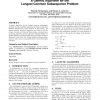229 search results - page 23 / 46 » Potential fitness for genetic programming |
GECCO
2008
Springer
13 years 8 months ago
2008
Springer
The aim of process mining is to identify and extract process patterns from data logs to reconstruct an overall process flowchart. As business processes become more and more comple...
GECCO
2009
Springer
14 years 10 days ago
2009
Springer
The notion of evolvability has been put forward to describe the“core mechanism”of natural and artificial evolution. Recently, studies have revealed the influence of the envi...
WAC
2005
Springer
14 years 1 months ago
2005
Springer
Truly autonomic networks ultimately require self-modifying, evolving protocol software. Otherwise humans must intervene in every situation that has not been anticipated at design t...
GECCO
2006
Springer
13 years 11 months ago
2006
Springer
A genetic algorithm for the longest common subsequence problem encodes candidate sequences as binary strings that indicate subsequences of the shortest or first string. Its fitnes...
GECCO
2005
Springer
14 years 1 months ago
2005
Springer
Evolutionary models typically rely on a single level of evolution for training a team of cooperating agents. I present a model that evolves at two levels—an “organizational”...

